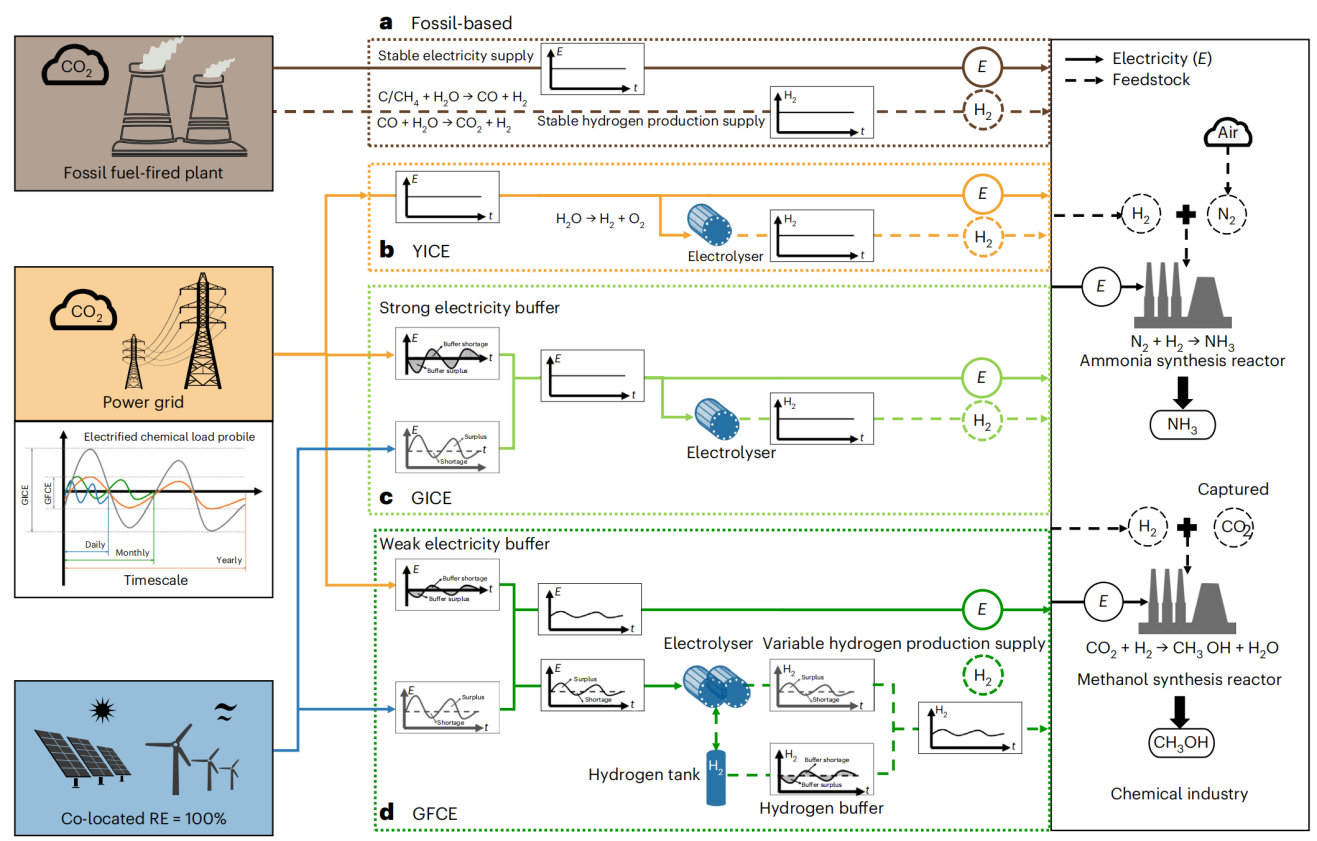On the path to achieving carbon neutrality, the chemical industry has long been a tough “nut to crack,” especially in the production of ammonia and methanol. These not only represent major products in the chemical industry but are also major sources of carbon emissions. The Department of Electrical Engineering and Applied Electronics (EEA) published a research paper titled “Redesigning electrification of China’s ammonia and methanol industry to balance decarbonization with power system security” online in Nature Energy. In this paper, the team proposes a new solution—the “Green Flexible Chemical Electrification” (GFCE) pathway, which, through the deep coupling of the power system and green hydrogen chemicals, enables direct green electricity integration to achieve electricity-hydrogen collaborative carbon reduction.
The Carbon Reduction Dilemma and Opportunities in the Chemical Industry
In China, the production of ammonia and methanol primarily relies on fossil raw materials such as coal. The coal-based chemical industry has a high carbon-to-hydrogen ratio, making ammonia and methanol synthesis one of the industries with the highest carbon emission intensity. Therefore, achieving deep decarbonization in the chemical industry without compromising production safety is an urgent issue that needs to be addressed.
A New Approach to Electricity-Hydrogen Synergy
Existing chemical electrification pathways mainly depend on grid electricity, but this often transfers carbon emissions from the chemical industry to the power industry, potentially even increasing national carbon emissions. To address this, the research team proposed a new approach—the “Green Flexible Chemical Electrification” (GFCE) pathway. This approach builds an integrated system through direct connection with green electricity, combined with advanced hydrogen-ammonia-methanol coupling control and scheduling technology, to achieve deep electrification in the chemical production process. Compared to electrification paths relying solely on grid power, the GFCE pathway not only significantly reduces carbon emissions in both the power and chemical industries, but also optimizes the operation through electricity-hydrogen synergy, reducing the impact on the power grid and enhancing the security of the power system.

Green Electricity Direct Connection to Green Hydrogen Chemical Industry: Electricity-Hydrogen Synergy Carbon Reduction Pathway
Key Technologies and Analytical Framework of the GFCE Pathway
The core of the GFCE pathway lies in two key attributes: “green” and “flexible.” “Green” refers to providing zero-carbon electricity raw materials to chemical production via direct connection to green electricity, achieving low-carbon emission reductions at the source. “Flexible” refers to the flexible operation of the electricity-hydrogen collaborative system, buffering the intermittency and volatility of renewable energy, enabling chemical production to achieve energy supply-demand balance at different time scales.
To comprehensively assess the performance of the GFCE pathway, the research team developed an integrated analytical framework that covers three key indicators: carbon emissions, power system security, and economic viability. The framework incorporates the following two core models:
Chemical Side Capacity Planning and Flexible Operation (CP&FO) Model: Based on industrial test data and process simulation, this model dynamically plans the capacity of renewable energy, electrolyzers, and hydrogen storage tanks, optimizing their operation to adapt to market and policy changes.
Power Side Economic Dispatch and Unit Commitment (ED&UC) Model: This model optimizes the national economic dispatch and provincial unit commitment to balance the efficiency and reliability of the power system, while considering the volatility of chemical production loads.
Additionally, the research team developed a detailed database covering data from the chemical industry and power systems in 22 provinces of China, including the distribution of renewable energy, chemical production loads, and power transmission networks. Using this data, the team conducted detailed simulations and analyses of the GFCE pathway for different provinces.
Performance and Advantages of the GFCE Pathway
Through detailed simulation and analysis of the 22 provinces, the research team found that by 2030, the GFCE pathway will have significant economic competitiveness nationwide. The production of green ammonia is expected to have a cost advantage over gray ammonia. Additionally, by optimizing the electricity pricing mechanism and further incentivizing flexible electricity demand management in the chemical industry, the synergy between the power and chemical industries can be enhanced.
Long-Term Development Trends and Policy Recommendations
The research also analyzed the long-term development trends of the GFCE pathway. The results show that as the penetration of renewable energy in the power and chemical industries continues to increase, the carbon reduction effect and economic viability of the GFCE pathway will improve. By 2050, the GFCE pathway is expected to be widely implemented nationwide, providing strong support for deep decarbonization in the chemical industry.
To promote the implementation of the GFCE pathway, the research team suggests the government introduce a series of supportive policies. For provinces where the production cost of green ammonia and green methanol is high, subsidies or carbon tax policies could be considered to lower investment barriers and promote market development. Additionally, the research proposes improving the electricity pricing mechanism to guide chemical production loads in ways that benefit grid operations, further enhancing the synergy between the power and chemical industries.
Conclusion
The “Green Flexible Chemical Electrification” pathway proposed by the EEA provides a new solution for the deep decarbonization of ammonia and methanol production, enabling the absorption of renewable energy and the green transformation of the chemical industry. Through direct connection of green electricity and the coupling of green hydrogen chemicals, it not only significantly reduces carbon emissions in the chemical industry but also enhances the security of the power system, providing strong support for achieving carbon neutrality. This research can serve as a technical reference for China’s renewable energy integration and the green transformation of the chemical industry. The EEA and Tsinghua Sichuan Energy Internet Research Institute have long been focused on key equipment and system control in the green hydrogen ammonia-methanol system, and the above work reflects the results of years of research on the front lines of the green hydrogen industry and engineering.
The paper is co-authored by Li Jiarong, Postdoctoral Fellow at Tsinghua University/Harvard University, Lin Jin from the EEA, Wang Jianxiao from Peking University’s National Engineering Laboratory of Big Data, and others. The research is supported by the National Key R&D Program's Hydrogen Energy Technology Special Project (100,000-ton renewable energy electrolysis hydrogen and ammonia synthesis demonstration project), Carbon Neutrality and Energy System Transformation (CNEST) Project, the National Natural Science Foundation, the Energy Foundation, and other projects. Special thanks to these supporters.
The article is available online at Nature Energy:
https://www.nature.com/articles/s41560-025-01779-9
DOI: 10.1038/s41560-025-01779-9.

















 News & Events
News & Events